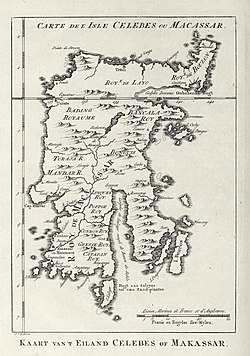Sultanate of Gowa | |||||||||||
|---|---|---|---|---|---|---|---|---|---|---|---|
| 14th century–1957 | |||||||||||
|
Flag | |||||||||||
 | |||||||||||
| Capital | Tamalate (1320–1548) Somba Opu (1548–1670) Jongaya (1895–1906) Sungguminasa (1936–present) | ||||||||||
| Common languages | Makassarese | ||||||||||
| Religion | Sunni Islam | ||||||||||
| Government | Monarchy | ||||||||||
| Sultan, Karaeng Sombayya ri Gowa | |||||||||||
• 1300 | Tumanurung | ||||||||||
• 1653-1669 | Sultan Hasanuddin | ||||||||||
• 1946-1957 | Sultan Aiduddin | ||||||||||
• 2021-present | Sultan Malikussaid II, Andi Kumala Idjo | ||||||||||
| History | |||||||||||
• Established | 14th century | ||||||||||
• Dissolution of Sultanate | 1957 | ||||||||||
| Currency | Jingaraʼ, Gold and copper coins was used in circulation, the Barter system was used | ||||||||||
| |||||||||||
| Today part of | Indonesia (as Gowa Regency) | ||||||||||

| History of Indonesia |
|---|
 |
| Timeline |
|
|
The Sultanate of Gowa was one of the great kingdoms in the history of Indonesia and the most successful kingdom in the South Sulawesi region. People of this kingdom come from the Makassar tribe who lived in the south end and the west coast of southern Sulawesi.
